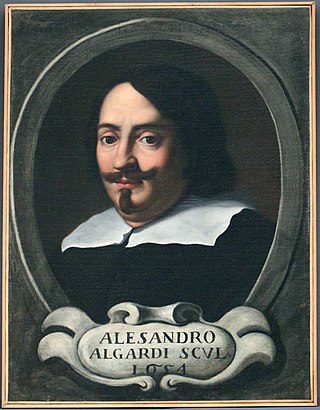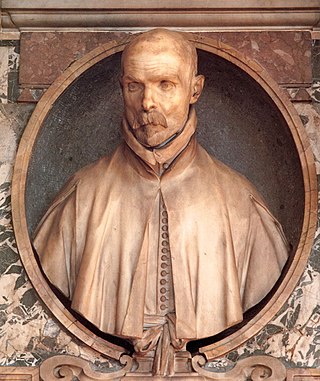
Alessandro Algardi was an Italian high-Baroque sculptor active almost exclusively in Rome. In the latter decades of his life, he was, along with Francesco Borromini and Pietro da Cortona, one of the major rivals of Gian Lorenzo Bernini, in Rome. He is now most admired for his portrait busts that have great vivacity and dignity.

Gian LorenzoBernini was an Italian sculptor and architect. While a major figure in the world of architecture, he was more prominently the leading sculptor of his age, credited with creating the Baroque style of sculpture.

Blessed Ludovica Albertoni is a funerary monument by the Italian Baroque artist Gian Lorenzo Bernini. The Trastevere sculpture is located in the specially designed Altieri Chapel in the Church of San Francesco a Ripa in Rome, Italy. Bernini started the project in 1671, but his work on two other major works—The Tomb of Pope Alexander VII and the Altar of the Blessed Sacrament in St. Peter's Basilica—delayed his work on the funerary monument. Bernini completed the sculpture in 1674; it was installed by 31 August 1674.

The Rape of Proserpina, more accurately translated as the Abduction of Proserpina, is a large Baroque marble group sculpture by Italian artist Gian Lorenzo Bernini, executed between 1621 and 1622, when Bernini's career was in its early stage. The group, finished when Bernini was just 23 years old, depicts the abduction of Proserpina, who is seized and taken to the underworld by the god Pluto. It features Pluto holding Proserpina aloft, and a Cerberus to symbolize the border into the underworld that Pluto carries Proserpina into.

Ippolito Buzzi (1562–1634) was an Italian sculptor from Viggiù, near Varese, in northernmost Lombardy, a member of a long-established dynasty of painters, sculptors and architects from the town, who passed his mature career in Rome. His personality as a sculptor is somewhat overshadowed by the two kinds of work he is known for: restorations to ancient Roman sculptures, some of them highly improvisatory by modern standards, and sculpture contributed to architectural projects and funeral monuments, where he was one among a team of craftsmen working under the general direction of an architect, like Giacomo della Porta - in projects for Pope Clement VIII, or Flaminio Ponzio - in projects for Pope Paul V - who would provide the designs from which the work was executed, always in consultation with the patron.

Truth Unveiled by Time is a marble sculpture by Italian artist Gian Lorenzo Bernini, one of the foremost sculptors of the Italian Baroque. Executed between 1645 and 1652, Bernini intended to show Truth allegorically as a naked young woman being unveiled by a figure of Time above her, but the figure of Time was never executed.

The Martyrdom of Saint Lawrence is an early sculpture by the Italian artist Gian Lorenzo Bernini. It shows the saint at the moment of his martyrdom, being burnt alive on a gridiron. According to Bernini's biographer, Filippo Baldinucci, the sculpture was completed when Bernini was 15 years old, implying that it was finished in the year 1614. Other historians have dated the sculpture between 1615 and 1618. A date of 1617 seems most likely. It is less than life-size in dimensions, measuring 108 by 66 cm.

Bust of Monsignor Pedro de Foix Montoya is a sculpted portrait by the Italian artist Gianlorenzo Bernini. Executed in 1621 and 1622, it sits within a larger tomb created for Montoya, a Spanish lawyer working in Rome. The tomb was originally in the Spanish national church in Rome, San Giacomo degli Spagnuoli, but was moved in the nineteenth century when the church fell out of Spanish possession. The monument now sits in the refectory attached to the Roman church of Santa Maria di Monserrato. The architecture for the tomb was undertaken by Orazio Turriani.

The Bust of Cardinal Escoubleau de Sourdis is a marble portrait sculpture by the Italian artist Gian Lorenzo Bernini. Executed in 1622, the work depicts François de Sourdis. It is currently in the Musée d'Aquitaine in Bordeaux, France.

The Bust of Camilla Barbadoni is a marble sculpture by the Italian artist Gian Lorenzo Bernini. Executed in 1619, it portrays the (deceased) mother of the Maffeo Barberini. Camilla had died in 1609. Barberini would become Pope Urban VIII in 1623.

The Bust of Francesco Barberini is a marble sculpture by the Italian artist Gian Lorenzo Bernini, now in the National Gallery of Art in Washington, D.C. It was executed in 1623. It was commissioned by Pope Urban VIII, who was a nephew of Francesco Barberini, an apostolic protonotary. Francesco had died in 1600, so Bernini created the bust from an existing painted portrait. That portrait is in the Corsini Collection in Florence; Bernini made close use of the design, although the painting was a three-quarter portrait as opposed to a bust of head, shoulders, and upper body.

The Bust of Cardinal Richelieu is a marble sculpture by the Italian sculptor Gian Lorenzo Bernini, situated at the Louvre in Paris.

Damned Soul is a marble sculpture bust by the Italian artist Gian Lorenzo Bernini as a pendant piece to his Blessed Soul. According to Rudolf Wittkower, the sculpture is in the Palazzo di Spagna in Rome. This may well be what is known today as the Palazzo Monaldeschi.

The Bust of Alessandro Peretti di Montalto is a portrait sculpture by the Italian artist Gian Lorenzo Bernini. Executed in 1622 and 1623, the sculpture is now in the Kunsthalle Hamburg, in Germany. Although possibly mentioned by one of Bernini's early biographers, the bust had been considered lost and therefore makes no appearance in Rudolf Wittkower's catalogue of Bernini’s sculptures of 1955. However, the bust was identified in the 1980s and is now considered an authentic work by Bernini.

The Blessed Soul is a bust by the Italian artist Gian Lorenzo Bernini. Executed around 1619, it is a pendant piece to the Damned Soul. Their original location was sacristy of the church of San Giacomo degli Spagnuoli, but they were then moved in the late 19th century, and then to the Spanish Embassy to the Holy See in Piazza di Spagna The set may have been inspired by prints by Karel van Mallery, although they were initially categorized as nymph and satyr.

The Bust of Pope Gregory XV is a marble portrait sculpture by the Italian artist Gian Lorenzo Bernini. Executed in 1621, the work is one of three busts of the subject created by Bernini—the other two were bronze casts. The marble bust is on permanent display at the Art Gallery of Ontario, in Toronto. It was donated to the museum by Joey and Toby Tanenbaum.

The Bust of Cardinal Melchior Klesl is a life-size marble bust of the seventeenth-century cardinal by Gianlorenzo Bernini and his assistants, notably Giuliano Finelli. It was probably executed in 1626. It is unclear how much of the work was executed by Bernini and how much by Finelli, or indeed others in Bernini's studio. The sculpture is part of Klesl's tomb in the cathedral of Wiener Neustadt, just south of Vienna.

Several sculpted busts of Pope Urban VIII were created by the Italian artist Gianlorenzo Bernini, with varying amounts of assistance from other artists in his workshop:
- Palazzo Barberini, Rome, 1623–1624. Marble.
- San Lorenzo in Fonte, 1626. Marble. Assistance by Giuliano Finelli.
- Galleria Nazionale di Arte, Palazzo Barberini, Rome, 1637–1638. Marble.
- Galleria Nazionale di Arte, Palazzo Barberini, Rome. Early 1640s. Marble. Largely the work of an assistant.
- Louvre, Paris. 1640. Bronze.
- Cathedral of Spoleto, 1642. Bronze.
- Collection Principe Enrico Barberini. Early 1640s. Porphyry. Adapted from existing antique statue, largely by assistants.
- Private Collection. 1658. Bronze

The Busts of Cardinals Agostino and Pietro Valier are two portrait sculptures executed by the Italian artists Gianlorenzo Bernini and his studio. They were commissioned in 1627. It is likely that the bust of Pietro was done largely by Andrea Bolgi following Bernini's design. The more lively portrait of Agostino is probably Bernini's design and execution.

The Raimondi Chapel is a chapel within the church of San Pietro in Montorio, Rome, Italy. The chapel houses the tombs of two members of the Raimondi family, Francesco and Raimondo. Both the architectural and sculptural elements of the chapel were designed by the artist Gianlorenzo Bernini - it was one of Bernini's first works where the relationship between the sculpture and the architecture was considered as a whole. Elements of the sculptures were executed by other artists in Bernini's circle; Andrea Bolgi did the busts of the two Raimondi brothers and the accompanying putti. Niccolò Sale undertook the reliefs on the tombs, while Francesco Baratta did the larger relief in the central altar. Work on the chapel took place between 1638 and 1648.






















